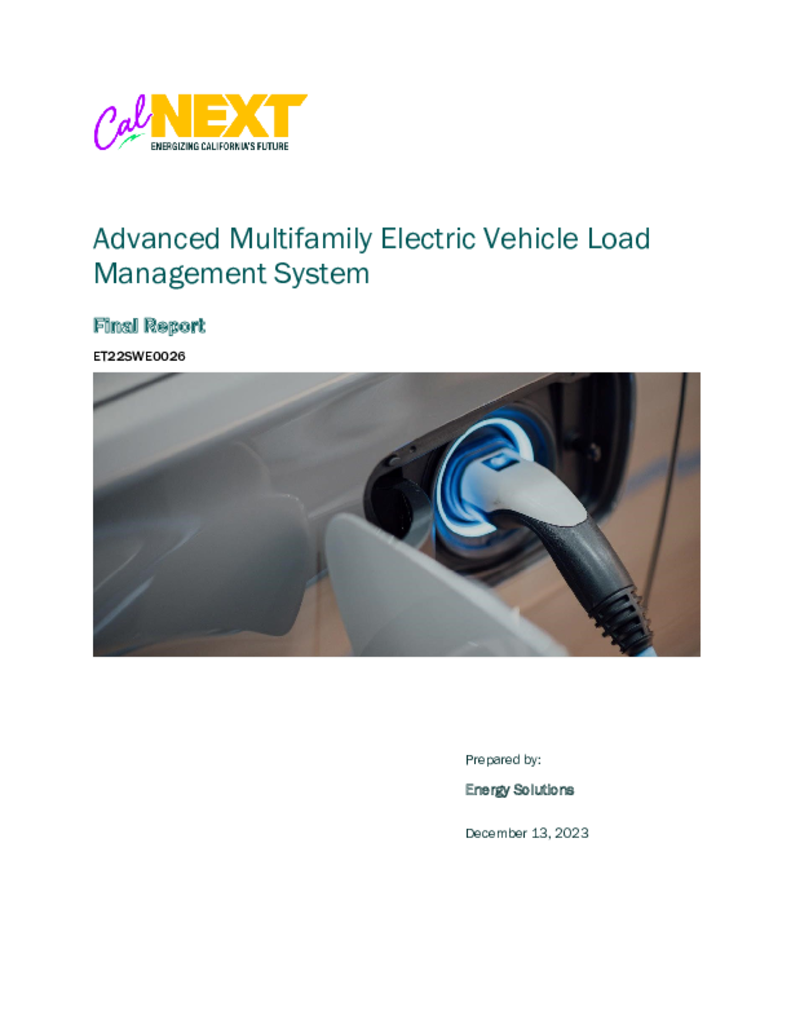ET22SWE0026 - Advanced Multifamily EV Load Management System
This project will test GoPowerEV, a new electric vehicle (EV) charging solution designed to provide access to charging in existing multifamily buildings with limited electrical capacity. GoPowerEV's combination of power-sharing capabilities, built-in load shifting, scalability, and affordable turnkey subscription model is unique in the market and provides an ideal charging solution for existing multifamily properties, including hard-to-reach (HTR) customers and disadvantaged communities (DACs) where affordability and ease-of-use is essential. This project will deploy GoPowerEV in at least four multifamily sites to test the ability of the technology to maximize EV charging access while meeting driver charging needs.
This emerging technology directly supports the high-priority electric vehicle supply equipment (EVSE) TPM technology family and will deliver significant energy savings. The baseline scenario for EV charging is full-power unmanaged 240V Level 2 charging – this is typically the standard in building codes and in IOU EVSE programs. A baseline Level 2 charger typically requires a dedicated 40A circuit and delivers power up to 7.68 kW (Level 2 can range from 3kW to 19kW of AC output and the actual power delivery depends on the vehicle being charged, but 7.68 kW is a common size). In this baseline scenario, unmanaged L2 chargers provide power to EVs when they first plug in. Per the DOE, the vast majority of aggregate EV demand is driven by home charging and a typical unmanaged EV charging load curve results in a peak in the late afternoon and early evening. At a multifamily site, providing even ten units with L2 EV charging would require 400 amps of capacity and add 76.8 kW peak load to the customer’s bill and local distribution system. GoPowerEV provides the following energy benefits over a Level 2 baseline installation:
- Energy savings: Each GoPowerEV base includes three ports, replacing multiple separate Level 2 EVSE units from another manufacturer and thereby reducing standby power from inactive units.
- Demand savings: GoPowerEV both flattens the EV charging load curve and shifts demand to off-peak hours. Average vehicle dwell time at multifamily buildings is typically in excess of 12 hours, but the average charging window is far less. In fact, the average daily vehicle miles traveled (VMT) for Californians is under 40 miles – this amount of range can be delivered by an L2 charger in under two hours and a Level 1 charger in just over seven hours. GoPowerEV’s Level 1 ports deliver the same amount of range over the course of a single dwell period but cut the peak demand by 4x. GoPowerEV also shifts the charging window to off-peak hours such that the kWh consumption and kW demand occurs after the 4-9 pm peak period. At just one relatively small multifamily site with six chargers (the minimum proposed for this pilot), that would provide a demand savings of over 46 kW.
- Lower system costs: GoPowerEV’s use of circuit-sharing and panel-sharing technology reduces the capacity needs on site and demand impacts on the grid, lowering both behind-the-meter installation costs and service upgrades and local distribution system improvements. This allows GoPowerEV to provide the same consumer benefits as the L2 baseline (kWh to support daily driving needs) with far less cost to the electric distribution system and ratepayers.
GoPowerEV’s customer base is primarily existing multifamily buildings, which are underserved by much of the EVSE market. Full-power networked Level 2 or Level 3 solutions, such as ChargePoint, EVgo, or others, typically use too much power to provide more than a handful of ports at a multifamily site without requiring significant (and expensive) infrastructure upgrades. More direct competitors are Level 1 “smart outlet” products such as Plugzio and Orange Charger. Energy Solutions has conducted a pilot for Peninsula Clean Energy deploying these solutions, and while they are dramatically more cost-effective than traditional Level 2 solutions they still do not leverage the panel-sharing or circuit-sharing capabilities of GoPowerEV. Energy Solutions has evaluated the market for automated load management system (ALMS) EVSE, both for PCE and independently, and while some solutions offer circuit-sharing (ex: NeoCharge), panel-sharing (ex: DCC), or networked power management (ex: EverCharge), GoPowerEV is the only product to combine all of these features. This has the potential to maximize the access to EV charging within a constrained electrical environment like a multifamily building.
GoPowerEV has begun initial conversations with SCE to raise awareness of its product capabilities and discuss inclusion in SCE’s larger EVSE programs including Multifamily Charge Ready. However, GoPowerEV is not on the approved vendor list and there is no current timeline for its inclusion. Moreover, there are zero Level 1 products currently approved for SCE’s light-duty EVSE rebates, and SCE’s Multifamily Turn-Key Installation Program requires Level 2 products. As a “smart outlet” providing both Level 1 and Level 2 capabilities, GoPowerEV is very different from the products SCE and other IOUs have traditionally included in rebate programs. This CalNEXT pilot provides an ideal opportunity to demonstrate the ability of GoPowerEV and similar products to meet multifamily EV driver needs. This will provide valuable information that the market and IOUs can use if they choose to help determine how to best address EV charging access in multifamily properties.
This project evaluates a new electric vehicle (EV) charging solution designed to provide charging access in existing multifamily buildings that have limited electrical capacity. This technology is worthy of study because it claims to offer features with significant potential for helping address barriers to implementing cost-effective multifamily EV charging access. Multifamily buildings rarely have available capacity to add traditional charging solutions for more than a few drivers, are often subject to significant demand charges (and grid impacts) from high-power charging solutions, require complex or expensive billing administration, and involve significant capital outlay to install EV chargers. This technology claims to offer power-sharing capabilities, built-in load shifting, scalability, and a turnkey subscription model which can help provide more charging access per site.

